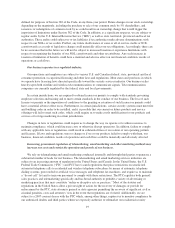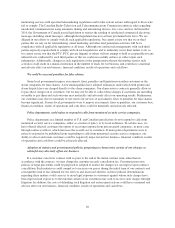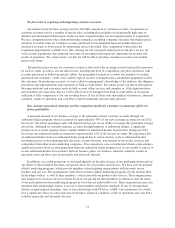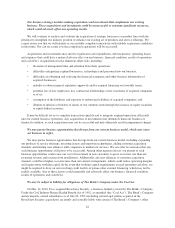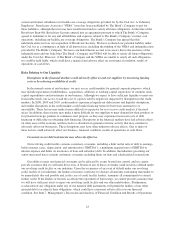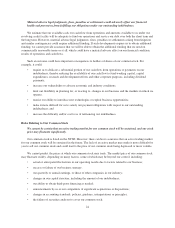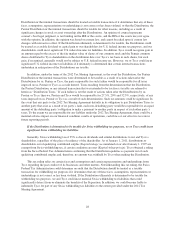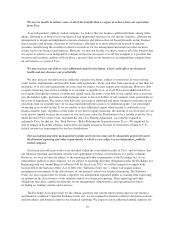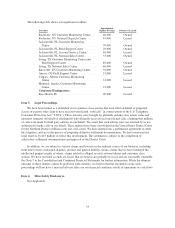ADT 2012 Annual Report Download - page 115
Download and view the complete annual report
Please find page 115 of the 2012 ADT annual report below. You can navigate through the pages in the report by either clicking on the pages listed below, or by using the keyword search tool below to find specific information within the annual report.current and former subsidiaries for health care coverage obligations provided for by the Coal Act. A Voluntary
Employees’ Beneficiary Associate (“VEBA”) trust has been established by The Brink’s Company to pay for
these liabilities, although the trust may have insufficient funds to satisfy all future obligations. At the time of the
Broadview Spin-Off, Broadview Security entered into an agreement pursuant to which The Brink’s Company
agreed to indemnify it for any and all liabilities and expenses related to The Brink’s Company’s former coal
operations, including any health care coverage obligations. The Brink’s Company has agreed that this
indemnification survives our acquisition of Broadview Security. We have evaluated our potential liability under
the Coal Act as a contingency in light of all known facts, including the funding of the VEBA and indemnification
provided by The Brink’s Company. We have concluded that no accrual is necessary due to the existence of the
indemnification and our belief that The Brink’s Company and VEBA will be able to satisfy all future obligations
under the Coal Act. However, if The Brink’s Company and the VEBA are unable to satisfy all such obligations,
we could be held liable, which could have a material and adverse affect on our financial condition, results of
operations or cash flows.
Risks Relating to Our Liquidity
Disruptions in the financial markets could adversely affect us and our suppliers by increasing funding
costs or by reducing availability of credit.
In the normal course of our business, we may access credit markets for general corporate purposes, which
may include repayment of indebtedness, acquisitions, additions to working capital, repurchase of common stock,
capital expenditures and investments in our business. Although we expect to have sufficient liquidity to meet our
foreseeable needs, our access to and the cost of capital could be negatively impacted by disruptions in the credit
markets. In 2008, 2009 and 2010, credit markets experienced significant dislocations and liquidity disruptions,
and similar disruptions in the credit markets could make financing terms for borrowers unattractive or
unavailable. These factors may make it more difficult or expensive for us to access credit markets if the need
arises. In addition, these factors may make it more difficult for our suppliers to meet demand for their products or
for potential strategic partners to commence new projects, as they may experience increased costs of debt
financing or difficulties in obtaining debt financing. Disruptions in the financial markets have had adverse effects
on other areas of the economy and have led to a slowdown in general economic activity that may continue to
adversely affect our businesses. These disruptions may have other unknown adverse effects. One or more of
these factors could adversely affect our business, financial condition, results of operations or cash flows.
Covenants in our debt instruments may adversely affect us.
Our revolving credit facility contains customary covenants, including a limit on the ratio of debt to earnings
before interest, taxes, depreciation, and amortization (“EBITDA”), a minimum required ratio of EBITDA to
interest expense and limits on incurrence of liens and subsidiary debt. In addition, the indenture governing our
senior unsecured notes contains customary covenants including limits on liens and sale/leaseback transactions.
Our ability to meet our financial covenants can be affected by events beyond our control, and we cannot
provide assurance that we will meet those tests. A breach of any of these covenants could result in a default under
our revolving credit facility or our indenture. Upon the occurrence of an event of default under our revolving
credit facility or our indenture, the lenders or trustees could elect to declare all amounts outstanding thereunder to
be immediately due and payable and, in the case of credit facility lenders, terminate all commitments to extend
further credit. If the lenders or trustees accelerate the repayment of borrowings, we cannot provide assurance that
we will have sufficient assets to repay our revolving credit facility and our other indebtedness. Furthermore,
acceleration of any obligation under any of our material debt instruments will permit the holders of our other
material debt to accelerate their obligations, which could have a material adverse effect on our financial
condition. See Item 7. Management’s Discussion and Analysis of Financial Condition and Results of Operations.
23








